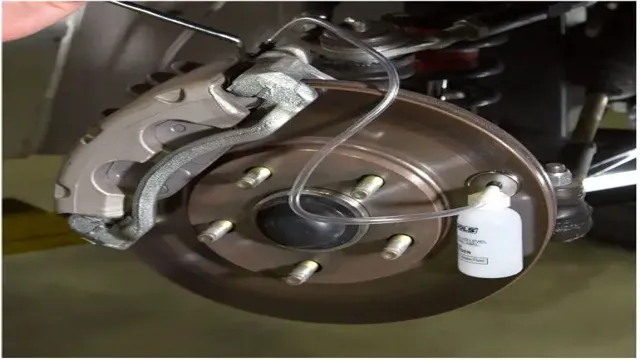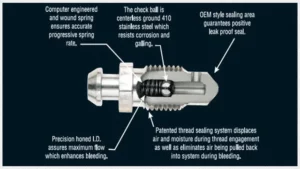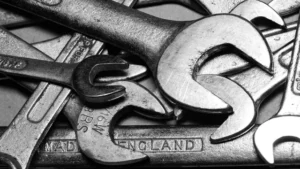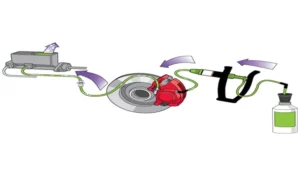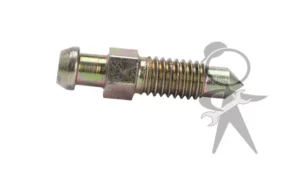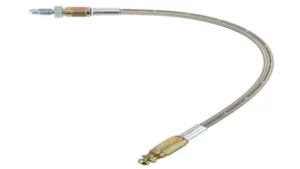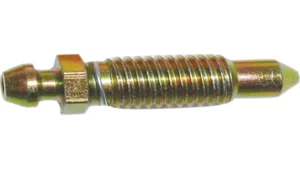Brake bleeding is a vital process that every car owner must learn to perform. It involves removing the air bubbles trapped in the brake system to ensure that the brakes function optimally. While many car owners prefer to take their vehicles to a professional mechanic for this procedure, there’s a way to DIY brake bleeding – using a one-man brake bleeder.
The one-man brake bleeder is a tool that allows you to bleed your car’s brakes without needing an extra pair of hands. It is simple to use and an affordable alternative to visiting a mechanic. With this tool, you can easily bleed and refill your brake fluid reservoir without any assistance.
Are you tired of spending a fortune at the mechanics for brake bleeding? Or maybe, you just want to become a more knowledgeable and hands-on car owner. Whatever your reason, the one-man brake bleeder is an effective and efficient tool that allows you to perform brake bleeding with ease. It offers you a sense of independence and helps you avoid the hassles of searching for a mechanic every time your brakes need bleeding.
Think of the one-man brake bleeder as a personal assistant that helps you complete a task without relying on anyone else. Imagine effortlessly completing the brake bleeding process in minutes without needing someone to pump the brake pedal while you open and close the bleeder valve. The one-man brake bleeder’s simplicity and proficiency are what every car owner needs.
In summary, brake bleeding is an important procedure to keep your vehicle’s brakes in top-notch condition. Using a one-man brake bleeder is a cost-effective and easy way to perform this procedure without any extra assistance. It is an essential tool that every car owner must-have.
What is a One Man Brake Bleeder?
One man brake bleeders are practical and efficient tools that allow you to bleed your brakes on your own. They are easy to use, and you don’t need any specialized knowledge to operate them successfully. If you’re wondering how to use one man brake bleeder, the process is relatively easy.
First, locate the brake bleeder screw on your brake caliper. Next, attach the one-man brake bleeder to the bleeder screw and attach the other end to the brake fluid reservoir. With the bleeder screw open, slowly pump the brake pedal until you see the old brake fluid exiting the system.
Keep topping the reservoir up with brake fluid until only new fluid flows through the system. Finally, make sure to tighten the brake bleeder screw and test your brakes to ensure proper functionality. With a little practice, using a one-man brake bleeder becomes an easy task.
And the best part is, you’ll save money and time you would typically spend taking your car to a garage to have your brakes bled.
Overview of the Tool
A one-man brake bleeder is a tool that enables an individual to bleed air out of a vehicle’s brake system without requiring a helper. Brake bleeding is a crucial maintenance task that ensures the braking system’s efficiency and safety. Air bubbles inside the brake fluid can obstruct the flow and cause brake failure, compromising the driver’s and passengers’ safety.
But with this tool, the process can be done by one person, making it easier and more convenient for vehicle owners to maintain their brakes. The one-man brake bleeder is a simple yet highly effective device that attaches to the brake bleeder valve, pressurizes the brake system, and pushes out any trapped air. It’s an affordable investment for anyone who wants to avoid the hassle of finding a second person to help with the brake bleeding process and ensure a safe braking system for their vehicle.
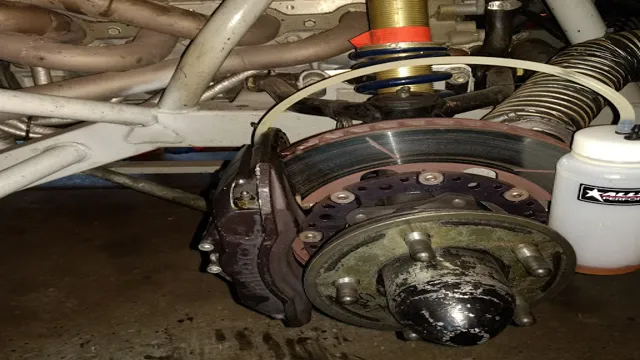
Step-by-Step Guide to Using a One Man Brake Bleeder
If you’re looking for a fast and easy way to bleed your brakes, a one-man brake bleeder might be the perfect tool for you. This device allows you to perform the job alone, without the need of an additional person to assist you. Here is a step-by-step guide on how to use a one-man brake bleeder: First, prepare your vehicle by elevating it on jack stands and removing the wheel from the brake caliper.
Next, connect the bleeder to your vehicle’s brake system by attaching the hoses to the caliper and the bleeder. Then, pump the brake pedal a few times to create pressure within the system. At this point, open the valve on the bleeder to allow the brake fluid to escape along with any air bubbles.
Finally, close the bleeder valve and refill your brake fluid reservoir. Repeat the process for each brake caliper, starting with the wheel furthest away from the master cylinder. Using a one-man brake bleeder can save time and eliminate the need for additional help, making the brake-bleeding task much simpler to accomplish.
Preparation
If you’re planning to use a one-man brake bleeder, it’s important to prepare properly to ensure success. Begin by gathering all the necessary tools, such as a wrench, pliers, and bleeder screws. It’s also helpful to have a catch pan or bucket to collect the brake fluid that will be expelled during the bleeding process.
Make sure your vehicle is parked on level ground, and consult your owner’s manual for any specific instructions on how to bleed your particular make and model. Take the time to inspect all components of your brake system for damage or wear, and replace any parts as needed before attempting to bleed the brakes. By properly preparing for the job at hand, you’ll be able to use your one-man brake bleeder with confidence and achieve optimal results.
Installation
Installing and using a one-man brake bleeder may seem intimidating at first, but with the right guide, it’s simple and easy to accomplish. Here’s a step-by-step guide to get you started. Firstly, park your car and ensure the brake rotors are cool to touch.
Then, remove the wheel on the braking system you want to bleed. With the brake bleed screw, connect the hose of the one-man brake bleeder. Subsequently, plug the end of the hose into the jar of the brake bleeder, making sure it is air-tight.
Pump the brakes until the jar is filled with brake fluid, then release the brake pedal. Repeat the process until you see clean brake fluid emerging from the hose, which indicates all the air has been removed from the system. Next, remove the brake bleeder hose, tighten the brake bleed screw, and replace the wheel.
Lastly, inspect the braking system to ensure everything is properly assembled, and then test the brakes before hitting the road. With these simple steps to guide you, using a one-man brake bleeder shouldn’t be a task that takes up too much of your time.
Bleeding the Brakes
When it comes to maintaining your vehicle’s brakes, bleeding the brake system is a crucial task that you should not overlook. Brake bleeding is essentially the process of removing trapped air from the brake system, which prevents the brakes from properly functioning and potentially causing accidents. One effective way to bleed the brakes is by using a one-man brake bleeder, which allows you to perform the task independently and with greater convenience.
The process involves attaching the bleeder to the brake pump, opening the bleed valve, and pumping the brake pedal until all the air bubbles have been removed from the system. It’s a simple and straightforward process, but it requires a bit of practice to master. When bleeding the brakes, it’s essential to use the proper equipment and exercise caution throughout the process for optimal results and safety.
By using a one-man brake bleeder, you can efficiently and thoroughly bleed your vehicle’s brakes with ease and peace of mind.
Tips and Tricks for Using a One Man Brake Bleeder
If you’re looking to bleed your brakes by yourself, a one man brake bleeder can be a great tool to use. However, it can be tricky to use if you’ve never done it before. Here are some tips and tricks to follow when using a one man brake bleeder: First, make sure your brake fluid reservoir is full and that you have the right type of brake fluid for your vehicle.
Then, attach the bleeder to one of your brake lines, making sure it’s secure. Next, start your car and pump the brake pedal a few times to build up pressure. Once you’ve done that, open the bleeder valve slightly and let the fluid flow into a container.
Keep an eye on the fluid level in your brake reservoir, and make sure it doesn’t go too low. You’ll want to bleed each brake until you see clean fluid coming out of the valve. If you’re having trouble getting the fluid to come out, try tapping on the brake line with a hammer to loosen any bubbles that may be trapped inside.
You can also try loosening the bleeder valve a little more, but be careful not to strip it. Remember, always follow the manufacturer’s instructions when using a one man brake bleeder. With a little practice, you’ll be able to bleed your brakes by yourself in no time! And don’t forget to check your brakes regularly to make sure they’re working properly.
Proper Maintenance
When it comes to using a one man brake bleeder, there are a few tips and tricks that can help ensure you get the best results. One of the most important things to keep in mind is proper maintenance. Before using your brake bleeder, make sure it’s clean and free of debris.
You should also regularly lubricate any moving parts to ensure smooth operation. Additionally, be sure to follow the manufacturer’s instructions for use and only use appropriate brake fluid for your vehicle. If you notice any leaks or malfunctions with your brake bleeder, address them immediately to avoid any potential safety hazards.
By keeping up with regular maintenance, you can help ensure that your one man brake bleeder works efficiently and effectively, giving you peace of mind when it comes to your vehicle’s brakes.
Avoiding Common Mistakes
If you’re using a one man brake bleeder, there are a few common mistakes you’ll want to avoid. First of all, make sure you’re attaching the bleeder to the right location on your vehicle. Check your owner’s manual or look up a tutorial online to make sure you’re doing it correctly.
Another mistake people often make is not properly sealing the bleeder valve, which can allow air to leak in and compromise the brake bleeding process. Take the time to make sure everything is tight and secure before you start. Additionally, it’s important to remember that brake fluid is highly corrosive, so be careful not to spill it on any painted surfaces or on your skin.
If you do get a spill, quickly clean it up with a rag or paper towel and dispose of it properly. By following these tips and tricks, you can ensure a successful brake bleeding experience with your one man brake bleeder.
Conclusion
In conclusion, using a one man brake bleeder is a game-changer for any DIY mechanic looking to simplify their brake bleeding process. It’s easy to use, efficient, and, most importantly, it can save you from the headache of dealing with messy brake fluid spills. Just follow the simple steps, and you’ll be in awe of how quickly and effortlessly you can bleed your brakes like a pro.
So, why not give it a try? Trust us, your brakes will thank you, and you’ll never go back to the old-school method of bleeding brakes.”
FAQs
What is a one man brake bleeder and how does it work?
A one man brake bleeder is a tool designed for bleeding air out of a vehicle’s brake system without assistance. The tool typically consists of a pump and hose that connect to the brake bleeding valve. To use it, the pump is pressed and the valve is opened to release air.
Can I use a one man brake bleeder on my car?
Most one man brake bleeder kits are universal and can be used on most cars. However, it is always important to check the manufacturer’s instructions to ensure compatibility with your particular make and model.
How do I prepare my car for using a one man brake bleeder?
Before using a one man brake bleeder be sure to check your car’s brake fluid level and ensure that the master cylinder is topped off with the correct type of brake fluid. Additionally, it is helpful to jack up the car and remove the wheels to access the brake calipers.
Are there any safety precautions I should take when using a one man brake bleeder?
Yes, it is important to wear protective eyewear and gloves when working with brake fluid as it can be corrosive. Additionally, be sure to avoid getting brake fluid on your skin or clothing as it can be difficult to remove.
How do I know when the brake system has been properly bled?
The best way to know that the brake system has been properly bled is to check for firmness in the brake pedal. If the pedal feels spongy or goes to the floor, there may still be air in the brake lines that needs to be bled out.
Are there any additional tools or equipment I need for using a one man brake bleeder?
Some one man brake bleeder kits may require additional tools such as pliers or wrenches to loosen or tighten the brake bleeding valve. Additionally, it is helpful to have a catch basin or container to collect any brake fluid that may leak out during the bleeding process.
Can I use a one man brake bleeder alone or do I need someone to help me?
One of the benefits of a one man brake bleeder is that it can be used alone without assistance. However, it is always helpful to have a second person to assist with monitoring the brake fluid level in the master cylinder and to help with any unexpected issues that may arise.
